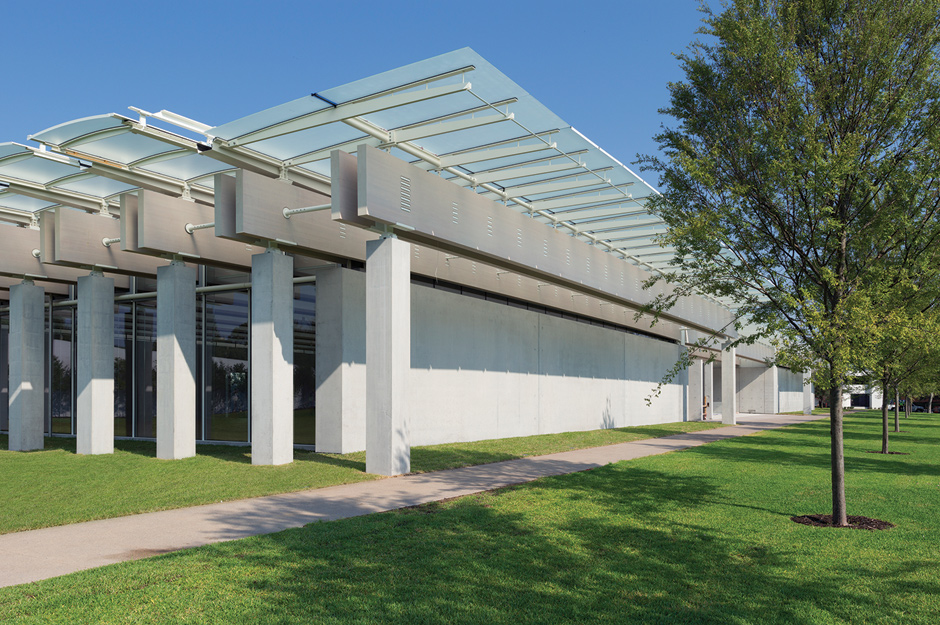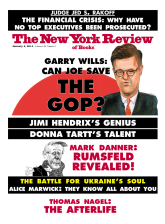
Robert LaPrelle
The north end of the new Renzo Piano Pavilion at the Kimbell Art Museum, Fort Worth, Texas. The entry façade is on the right. Additional views of the building can be seen on the NYRblog.
The good news is that the Renzo Piano Pavilion, its eponymous architect’s long-awaited addition to Louis Kahn’s Kimbell Art Museum of 1966–1972 in Fort Worth, is far from the disaster feared by many admirers of the most revered twentieth-century gallery. There is no bad news, only mild regret that the new $135 million building is not very distinguished, especially in light of what I believe to be Piano’s masterpiece, only thirty-two miles away in Dallas, his Nasher Sculpture Center of 1999–2003. More than ever before, the Nasher struck me during a recent visit as its designer’s equivalent of Kahn’s Kimbell, a warm and embracing fusion of art and architecture that seems increasingly remarkable each time I see it.
Conversely, my primary response to Piano’s Kimbell expansion is relief that it does not harm the adjacent landmark, as would have happened had Romaldo Giurgola’s controversial 1989 expansion plan for the original Kahn building been implemented. Giurgola proposed extending Kahn’s series of parallel modular units with replicas of his concrete-framed, travertine-clad oblongs and barrel-vaulted lead roofs bisected by linear skylights. Although Kahn’s first scheme included more units than the version ultimately executed, Giugola’s ill-advised expansion, which provoked an outcry from preservationists, ended any further notion that the building could be altered by direct enlargement.
To be sure, matters would be much improved had the freestanding Renzo Piano Pavilion been placed elsewhere on the museum’s ample property—specifically a vacant lot just across Van Cliburn Way to the east of the Kahn galleries, used as an auxiliary parking lot for Tadao Ando’s Modern Art Museum of Fort Worth (1997–2002). Piano devised a promising initial plan for that unobtrusive location, but the Modern Art Museum wanted to keep the parking lot (even though it is owned by the Kimbell) and a different scheme was prepared for the site to the west of the Kahn building, where the 101,000-square-foot addition now stands.
Its design reiterates the format Piano has used in several other museum buildings: a low-rise rectangle with a flat overhanging roof supported by a modern version of the Classical colonnade, a single continuous row of columns set out from the structure’s outer walls and supporting the extended roof above the configuration, first seen in his elegant but emotionally restrained Menil Collection of 1982–1986 in Houston. At the new Fort Worth pavilion, there is an odd disjunction between the three-hundred-foot-long entry façade—from which you see the Kahn building across a broad grassy lawn—and the one-hundred-foot-long side elevations, which overlook streets to the north and south.
The Piano addition is connected to the Kahn building by an underground parking garage and by a walkway across the lawn between them. Most visitors will leave their cars in the garage and ascend by stairs or elevator to the new pavilion; there is no direct access for the public to the Kahn building from the garage, though those using the original aboveground parking lot will enter the old galleries through the east door as before. A subterranean tunnel between the two can be used upon request by people in wheelchairs.
The Piano Pavilion’s tripartite front is bland beyond the norms of Minimalism, with a pair of blank concrete walls that frame a central segment of ground-to-roof glass panels and portals, the detailing of which is routine at best. As one stands in the west-facing courtyard of the Kahn building, with its famous grove of yaupon hollies, the entry façade of Piano’s addition nearly fades away. Alas, the same cannot be said of its overwrought north and south ends, which seem ill-proportioned thanks to the massive, hundred-foot-long, gray-stained, laminated Douglas fir roof beams that jut beyond the glass walls beneath them and give the composition a top-heavy quality reminiscent of 1970s Brutalism. Supporting those narrower elevations, a row of eleven squared-off concrete columns (echoing the corner supports of the Kahn gallery’s porticoes) are spaced a mere ten feet apart and thus make the building appear to be sinking under its own weight.
The new addition is actually two separate structures conjoined: an entry-and-gallery pavilion, behind which, half-buried beneath a green-roof earth berm, is a subterranean component that contains a double-height, 298-seat auditorium; a handsome library; various education facilities, including classrooms and children’s art studios; and a cave-like gallery dedicated to works of Asian art. The main virtue of this crepuscular space is that it allows fragile works with stringent light-control requirements—such as scrolls, screens, and textiles—to be displayed together.
Despite deferential gestures to the Kahn building, the Piano Pavilion blocks the once westward-sweeping vista toward Philip Johnson’s Amon Carter Museum of American Art of 1958–1961, another cornerstone of Fort Worth’s estimable cultural district. Johnson’s building, from his so-called Ballet School Period, is hardly in the same architectural league as Kahn’s Kimbell, but it possesses a certain campy charm akin to a folly at the terminus of a Baroque garden axis. That erstwhile view is now obscured behind an ungainly concrete retaining wall that one hopes will soon be camouflaged by greenery. The pavilion’s rather perfunctory landscape design, by the Georgia firm Pond & Company, omits much-needed foundation plantings on the bare concrete-and-glass façade confronting the Kahn building, and leaves a great deal to be desired, typified by a cluster of yaupon hollies plunked down in front of the south end like an oversized bunch of parsley.
Advertisement
In a tactical error, the Kimbell decided to temporarily display its permanent collection in the Piano Pavilion during the current loan exhibition, “The Age of Picasso and Matisse: Modern Masters from the Art Institute of Chicago,” which is given pride of place in the old building. Ironically, this superb show owes something to Piano as well, because the works became available when the problem-plagued third floor of his Modern Wing at the Art Institute was closed for seven months of repairs this September, only four years after the building’s completion.
The switch invites unfortunate comparisons. With their celebrated skylit concrete ceiling vaults and use of creamy travertine on the walls, Kahn’s interiors virtually caress pictures shown within them, in an almost uncanny melding of sensitively proportioned volume and mysteriously modulated light. Not surprisingly, the Art Institute’s best twentieth-century pictures here look better than they ever have at home. Though the Kimbell’s Old Master paintings can be adequately viewed in Piano’s new galleries, they unquestionably seem less magical there, and one awaits their return to Kahn’s spaces, where they used to fairly glow.
The works that fare best in the Piano Pavilion’s three major display areas are the non-European sculptures mounted in the pellucidly lit north gallery (illuminated, as is the south gallery, by a combination of natural and artificial overhead lighting). Among them are the museum’s choice pre-Columbian artifacts and superb African tribal objects, the latter exemplified by an Ife terra-cotta head, circa 1100–1300 CE, arguably the finest treasure from that continent in this hemisphere.
The pavilion’s triumph is its exquisitely wrought concrete walls—supervised by the Dottor Group, an Italian architectural restoration firm—which were poured in unusually large and smoothly finished wooden formworks to minimize the seams and circular indentations that can be so distracting when viewing art against conventionally made concrete surfaces. The material exudes a low-key silvery sheen thanks to a 2 percent addition of titanium to the ingredients—the most ravishing concrete I have seen in the US.
It is regrettable that craftsmanship of this superlative quality could not have been obtained for the fabrication of Kahn’s Franklin D. Roosevelt Four Freedoms Park of 1972–2012 on New York City’s Roosevelt Island. Although the architect had originally intended to use concrete, his hallmark material, the project’s latter-day sponsors—who revived and realized the scheme decades after Kahn’s death in 1974—insisted on a highly finished (and to my eyes rather dead) granite because they feared that local concrete contractors could not provide a fine enough result.
With its unrestricted endowment of some $400 million, the Kimbell is able to compete for the best works on the international market. Among its world-class acquisitions just since the turn of the millennium are an introspective Classical bronze athlete’s head in the manner of Lysippos; a bas-relief Virgin and Child attributed to Donatello; a rare early Michelangelo easel painting, The Torment of Saint Anthony; Poussin’s majestic canvas The Sacrament of Ordination; and a fearsome pair of monumental Mayan ceramic sculptures. Piece for piece, the Kimbell collection sets an extraordinarily high standard of quality and discernment. They spend big, they spend right, and no institution today does it better.
Most importantly, the Kimbell maintains a free-admission policy for its permanent collection (there is a fee for changing exhibitions) at a time when high tariffs at other American museums—most notably New York’s MoMA, which charges an exorbitant $25 for adults—debar large segments of the citizenry from access to artworks presumably held in the public trust, and often supported in part by municipal taxes. The Kimbell’s extensive education and community outreach programs are thoroughly admirable, as is its accommodation of major traveling shows that formerly necessitated emptying half the Kahn building. Although at first I had been skeptical about the Kimbell’s urge to enlarge what is universally considered the perfect small museum, I now acknowledge it to have been a sound idea after all.
Advertisement
Architecturally, the new Kimbell addition will soon fade into the middle rank of Piano’s oeuvre, neither at the top (the Nasher and Menil) nor the bottom (the Broad Contemporary Art Museum of 2003–2008 in Los Angeles and the Morgan Library & Museum of 2000–2006 in New York.) His Fort Worth pavilion is the twenty-first museum building Piano has completed, with another four in the works, and he cannot be expected to produce a hit every time.
One can easily imagine an outcome better in several respects—a shelter lighter, more ethereal, and livelier than this dull affair. Yet we should also be grateful that the architect and his client were so cautious. The extreme preoccupation over the success or failure of the Renzo Piano Pavilion is indicative of the dominance that architecture has disproportionately assumed in the evaluation of art institutions since Frank Gehry’s Guggenheim Museum Bilbao opened in 1997.
This is not to say that the buildings in which works of art are housed should be beside the point, but great architecture alone does not guarantee a great museum. After having hoped for the architectural equivalent of a unique masterpiece, the Kimbell can now get back to the most crucial business of any art museum: acquiring the finest objects available, presenting them freely to the public, and preserving them for the benefit of generations to come.



